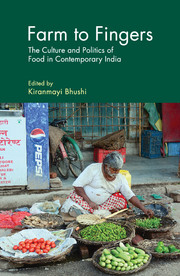Book contents
- Frontmatter
- Dedication
- Contents
- List of Figures and Tables
- Preface
- 1 Introduction
- 2 The Making of ‘Edible Animal Source Foods’ and its Contemporary Reality in Delhi
- 3 Appropriating the Cow: Beef and Identity Politics in Contemporary India
- 4 Eating Akhuni in India
- 5 Health, Standardization and ‘Bengali’ Sweets
- 6 Treating Children, Feeding Junk Food: An Inquiry into a Middle Class Project
- 7 Diaspora Dish: Cooking, Writing, and Creating Identities in Food-blogs
- 8 Measuring Hunger: Debates on an ‘Adequate’ Diet in Colonial North India
- 9 Managing Food: India's Experience with the Public Distribution System
- 10 Food Sovereignty: The Future of Food
- Contributors
- Index
9 - Managing Food: India's Experience with the Public Distribution System
Published online by Cambridge University Press: 05 July 2018
- Frontmatter
- Dedication
- Contents
- List of Figures and Tables
- Preface
- 1 Introduction
- 2 The Making of ‘Edible Animal Source Foods’ and its Contemporary Reality in Delhi
- 3 Appropriating the Cow: Beef and Identity Politics in Contemporary India
- 4 Eating Akhuni in India
- 5 Health, Standardization and ‘Bengali’ Sweets
- 6 Treating Children, Feeding Junk Food: An Inquiry into a Middle Class Project
- 7 Diaspora Dish: Cooking, Writing, and Creating Identities in Food-blogs
- 8 Measuring Hunger: Debates on an ‘Adequate’ Diet in Colonial North India
- 9 Managing Food: India's Experience with the Public Distribution System
- 10 Food Sovereignty: The Future of Food
- Contributors
- Index
Summary
Introduction
In India, debates over ensuring access to adequate food for the needy are quite old. The Food Security Bill, which was passed by the parliament in 2013 (GOI 2013), animated an expected round of deliberations among activists, politicians, economists, and media commentators on how to feed the hungry. This is not going to be the last such exercise because the scale of hunger prevailing in the country is enormous. In the Global Hunger Index Ranking published by the International Food Policy Research Institute, India was the 16th most-hungry country among 78 developing countries in 2013. It was among the only three countries outside sub-Saharan Africa that displayed ‘alarming’ levels of hunger (IFPRI 2013).
These rankings reveal India's relative position vis-a-vis other countries, but do not contain information about the state of hunger within the country. Therefore, some figures on this are in order. According to the National Family Health Survey of 2005-06, about 45.9 per cent of children below three years of age were malnourished. Among married women in the age group of 15 to 49 years, about 56 per cent were anaemic. Among pregnant women, prevalence of anaemia was even higher, at 58 per cent. Of course, prevalence of malnourishment is not limited to women and children. According to data collected by the National Nutrition Monitoring Bureau, about 49 per cent of adults had a body mass index (BMI) below the prescribed norm in 1993-94 (Swaminathan 2008). In 2005-06, India had a mean BMI of 19.9, which was below the levels seen in many sub-Saharan countries like Cameroon, Congo, Democratic Republic of Congo, Kenya, Malawi, Mali, Niger and Nigeria. It is indeed worrying that the tide of high economic growth that India experienced in recent decades did not translate into significant improvement in access to food. For example, in the seven years from 1998-99 to 2005-06 prevalence of malnourishment among children declined by a mere 0.8% point. For some other measures, the improvement has been even more limited. Therefore, it is hardly surprising that this gigantic burden of hunger, which saps the body and spirit of the nation, spurs heated debate and passionate discussion.
- Type
- Chapter
- Information
- Farm to FingersThe Culture and Politics of Food in Contemporary India, pp. 215 - 235Publisher: Cambridge University PressPrint publication year: 2017
- 1
- Cited by

